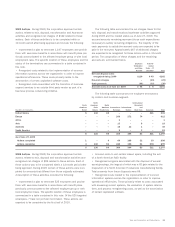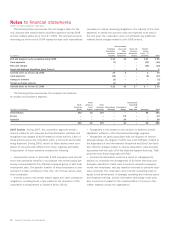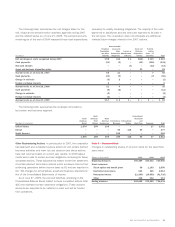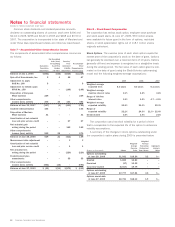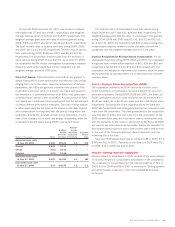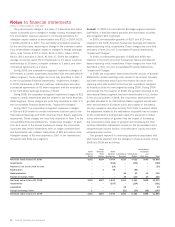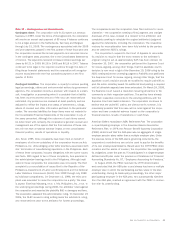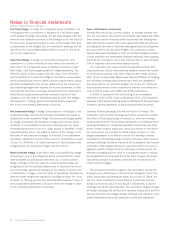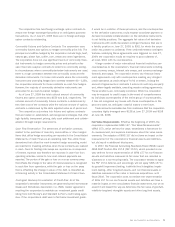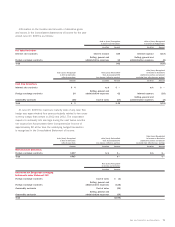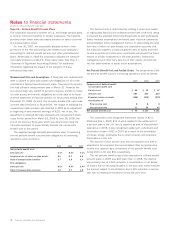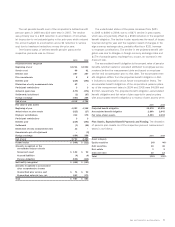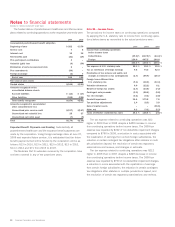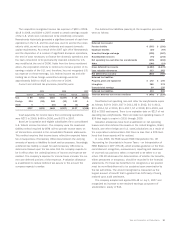Sara Lee 2009 Annual Report Download - page 73
Download and view the complete annual report
Please find page 73 of the 2009 Sara Lee annual report below. You can navigate through the pages in the report by either clicking on the pages listed below, or by using the keyword search tool below to find specific information within the annual report.Note 17 – Guarantees
The corporation is a party to a variety of agreements under which
it may be obligated to indemnify a third party with respect to certain
matters. Typically, these obligations arise as a result of contracts
entered into by the corporation under which the corporation agrees
to indemnify a third party against losses arising from a breach of
representations and covenants related to matters such as title to
assets sold, the collectibility of receivables, specified environmental
matters, lease obligations assumed and certain tax matters. In each
of these circumstances, payment by the corporation is conditioned on
the other party making a claim pursuant to the procedures specified
in the contract. These procedures allow the corporation to challenge
the other party’s claims. In addition, the corporation’s obligations
under these agreements may be limited in terms of time and/or
amount, and in some cases the corporation may have recourse
against third parties for certain payments made by the corporation.
It is not possible to predict the maximum potential amount of future
payments under certain of these agreements, due to the conditional
nature of the corporation’s obligations and the unique facts and
circumstances involved in each particular agreement. Historically,
payments made by the corporation under these agreements have
not had a material effect on the corporation’s business, financial
condition or results of operations. The corporation believes that
if it were to incur a loss in any of these matters, such loss would
not have a material effect on the corporation’s business, financial
condition or results of operations.
The material guarantees for which the maximum potential
amount of future payments can be determined, are as follows:
•The corporation is contingently liable for leases on property
operated by others. At June 27, 2009, the maximum potential amount
of future payments that the corporation could be required to make
if all the current operators default is $135. This contingent obliga-
tion is more completely described in Note 13 to the Consolidated
Financial Statements, “Leases”.
•The corporation has guaranteed the payment of certain third-party
debt. The maximum potential amount of future payments that the
corporation could be required to make, in the event that these third
parties default on their debt obligations, is $16. At the present
time, the corporation does not believe it is probable that any of
these third parties will default on the amount subject to guarantee.
Additionally, the corporation has pledged as collateral, a manufac-
turing facility in Brazil in connection with a tax dispute in that country.
Note 18 – Financial Instruments
Background Information The corporation uses derivative financial
instruments, including forward exchange, futures, options and swap
contracts, to manage its exposures to foreign exchange, commodity
prices and interest rate risks. The use of these derivative financial
instruments modifies the exposure of these risks with the intent to
reduce the risk or cost to the corporation. The corporation does not
use derivatives for trading or speculative purposes and is not a
party to leveraged derivatives.
The corporation recognizes all derivative instruments as either
assets or liabilities at fair value in the consolidated balance sheet.
The corporation uses either hedge accounting or mark-to-market
accounting for its derivative instruments. For derivatives that
qualify for hedge accounting, the corporation designates these
derivatives as fair value, cash flow or net investment hedges by
formally documenting the hedge relationships, including identifica-
tion of the hedging instruments and the hedged items, as well as
its risk management objectives and strategies for undertaking the
hedge transaction. The process includes linking derivatives that
are designated as hedges of specific assets, liabilities, firm
commitments or forecasted transactions.
As noted above, the corporation uses derivative financial
instruments to manage its exposure to commodity prices. A com-
modity derivative not declared a hedge in accordance with SFAS 133,
”Accounting for Derivative Instruments and Hedging Activities,” is
accounted for under mark-to-market accounting with changes in
fair value recorded in the Consolidated Statements of Income. Prior
to 2009, gains and losses on unrealized commodity derivatives
accounted for under mark-to-market accounting were included in
segment operating income. In 2009, the corporation now includes
these unrealized mark-to-market gains and losses in general corpo-
rate expenses until such time that the exposure being hedged affects
the earnings of the business segment. At that time, the cumulative
gain or loss previously recorded in general corporate expenses for
the derivative instrument will be reclassified into the business
segment’s results.
On the date the derivative is entered into, the corporation
designates the derivative as one of the following types of hedging
instruments and accounts for the derivative as follows:
Sara Lee Corporation and Subsidiaries 71


